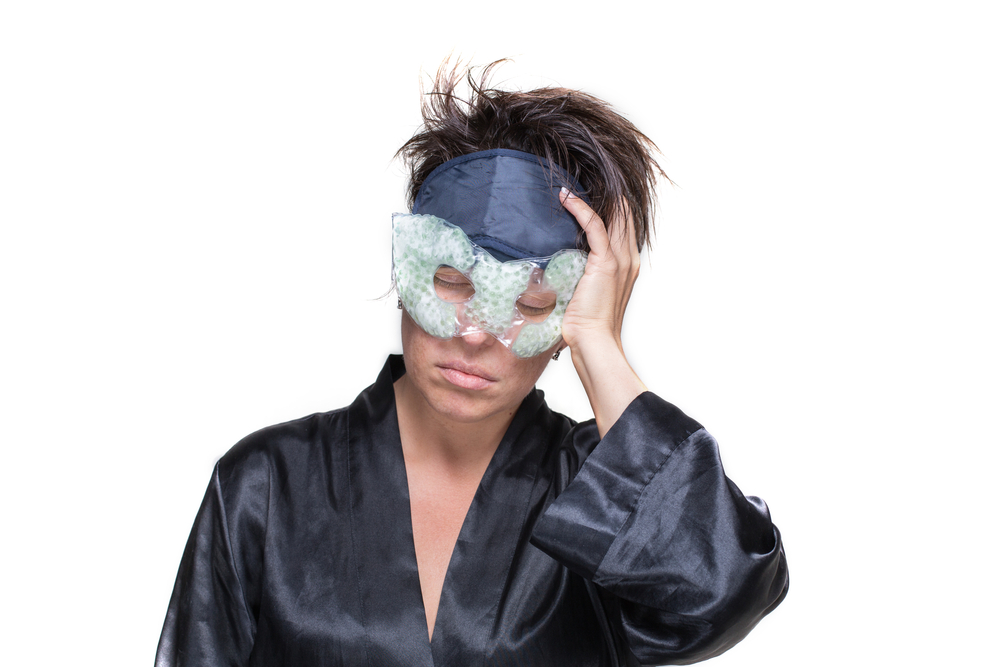Do you find yourself searching for effective natural relief of debilitating headaches and migraines that doesn’t involve relying on prescription medications? Look no further than the simple yet powerful home remedy solution of an ice pack for headache or migraine headaches. In this comprehensive guide, we will explore the benefits of using ice packs for headache relief, the best types of ice packs for migraines, the best place to put an ice pack for migraine, and the correct way to use them safely for maximum effectiveness.
Understanding the Role of Ice Packs in Headache and Migraine Relief
The effectiveness of gel ice packs in providing solace from the throes of migraine head pain is well-documented and deeply rooted in their ability to diminish pain and inflammation. By delivering a cold stimulus, ice packs and cold compresses induce vasoconstriction—the narrowing of blood vessels—throughout the head and face, thus mitigating blood flow to areas plagued by pain. This not only lessens the severity of pain but also addresses the inflammation and tissue swelling that often accompanies migraine attacks.
Furthermore, the cooling effect from ice packs or a headache hat offers a numbing sensation that serves as immediate, albeit temporary, relief from the acute discomfort associated with both tension headaches and migraine headaches. This dual action—reduction in inflammation and provision of analgesic relief—positions ice packs as a cornerstone in the non-pharmacological management of headaches and migraines.
For these reasons, cold therapy is almost always preferred over heat therapy or a heating pad by migraine sufferers during acute treatment.
Types of Ice Packs and Their Benefits for Headache Relief
Navigating the diverse landscape of ice packs reveals a wealth of convenient options, each tailored to meet the specific needs of individuals suffering from headaches.
Among the most popular choices are gel-filled cold packs, known for their flexibility and ability to contour to the head, providing focused relief to areas under siege by pain.
Migraine hats, migraine ice caps, and cold caps are basically cold gel caps that stay in place without having to hold them there yourself. A migraine relief cap offers migraine patients the freedom to move about while simultaneously undergoing cold therapy for their headache pain. These innovative solutions come equipped with features designed to address the unique contours of the head, ensuring that relief is both comprehensive and consistent. They come in many forms ranging from a simple ice eye mask to a full head mask covering the top of your head, sides of your head, back of your head, neck, and around your eyes.
Of course there are the basic options that some can get away with such a traditional ice pack, the classic bag of frozen peas covered in a thin towel, or cold water over the head or on a stretchy fabric wrapped around the head.
Additionally, for those seeking a more personalized approach, the option to create custom ice packs allows for adjustments in size, shape, and intensity of cold, catering to the individual’s specific pain points. This variety in ice pack technology underscores the commitment to offering versatile and effective solutions for those navigating the challenging frozen waters of headache and migraine relief.
Is an Ice Pack Good for a Migraine Headache?
Absolutely! Employing an ice pack can be profoundly beneficial for those enduring the miserable discomforts of a migraine headache. The application of cold temperatures to areas of pain works effectively to dull the ache and reduce inflammation—a frequent companion of migraine episodes. For many who experience these severe headaches, the targeted cold therapy provided by ice packs is a key element in their pain management strategy.
This method of relief leverages the body’s natural response to cold, promoting vasoconstriction which in turn can alleviate the pain signal intensity. Individuals often report significant reductions in the severity of their migraine symptoms when applying ice packs to strategic areas such as the forehead or neck. This simple, yet effective approach offers a non-invasive and drug-free option for managing the acute phases of migraine attacks, highlighting the importance of cold therapy in the broader spectrum of migraine relief strategies.
What is the Best Ice Pack for Migraine Headaches?
Choosing the most effective ice pack for migraine headaches requires a thoughtful consideration of your personal comfort, the severity of your migraines, and how you respond to cold therapy. Is there a best way to use cold treatment? It really comes down to personal preference.
Gel-filled packs are favorites for their convenience and adaptability, conforming closely to your head to deliver soothing relief precisely where it’s needed.
Migraine caps, on the other hand, are designed for ease of use, allowing you to go about your daily activities while benefiting from consistent cold pressure.
For those who prefer a more tailored approach, DIY (Do It Yourself) ice packs—created with a mix of water and rubbing alcohol—offer flexibility in shape and intensity, providing a customizable solution to your pain relief regimen. We’ll discuss these further down.
It’s important to experiment with different types of ice packs to discover which option best aligns with your needs, offering you the most effective relief during migraine episodes. Remember, the efficacy of an ice pack can also be influenced by how it is used, including the duration of application and the specific areas of focus on the head or neck.
Where is the Best Place to Put an Ice Pack for a Migraine?
Identifying the optimal placement for an ice pack during a migraine attack is crucial for achieving the maximum therapeutic effect. The forehead, temples, and the base of the skull at the top of the neck are common areas where migraine pain tends to be most intense. So these areas tend to be the most popular places to put an ice pack during a migraine attack. Applying cold therapy to these specific locations can usually provide direct relief where it’s needed most.
However, it’s worth experimenting with the ice pack’s position to tailor your approach to pain relief, as individual experiences with migraine pain can vary. Adjusting the placement based on where you feel the most pain or discomfort can help in decreasing your migraine pain, and should be the first area to experiment on. A head wrap can be used to keep the ice pack in a specific head location. Engaging in this process allows for a personalized strategy that caters to your unique migraine pain pattern.
Best Practices, Safety Tips, and Precautions for Ice Pack Application to Maximize Relief
To harness the full potential of an ice pack in alleviating headache discomfort, it’s critical to employ a methodology that emphasizes both safety and efficiency. Begin by encasing the ice pack in a protective layer such as a soft cloth or thin towel. This creates a barrier between the ice and your skin, thereby minimizing the risk of frostbite. This practice not only ensures a safer application but also facilitates a more gradual and comfortable transfer of cold.
Limit the application of the ice pack to periods of 20 minutes, allowing the skin to return to its normal temperature between sessions to avoid any potential skin damage from prolonged cold exposure. Be attentive to your body’s responses during cold therapy; if you notice any adverse reactions, such as increased pain, skin redness, or numbness, stop use immediately and evaluate whether an alternative treatment may be more appropriate.
Observing these safety measures will help maintain the balance between relief and well-being in your approach to managing headache symptoms with ice therapy.
How Do You Make an Ice Pack for a Headache?
Crafting a DIY ice pack for headache relief is both an affordable and effective strategy. To begin, you will need a tightly sealable plastic bag. Into this bag, place a combination of ice cubes or crushed ice. Adding a modest amount of water to the mix will aid in ensuring that the cold is evenly distributed across the affected area, providing more consistent relief.
For those in search of an ice pack with a bit more flexibility, which can be particularly useful for conforming to different parts of the head, a mixture of water and rubbing alcohol is recommended. This concoction should be frozen until it reaches the desired consistency. Before applying this homemade ice pack to the areas of discomfort, it’s crucial to wrap it in a soft cloth or thin towel. This extra step is vital, as it not only prevents direct contact with the skin, which could lead to cold injuries, but it also enhances the comfort of the application, making your headache relief experience as soothing as possible.
When to Seek Professional Medical Advice
While leveraging ice packs for migraine and headache relief can be highly effective, it’s imperative to understand their limitations. Persistent or escalating symptoms, despite these interventions, should prompt consideration of a professional evaluation. Engaging with a healthcare professional ensures a comprehensive assessment of your condition, helping to rule out any serious underlying issues that could be contributing to your headaches. It’s also an opportunity to explore a broader spectrum of treatment options tailored to your specific needs.
Remember, managing your health should be a balanced approach between home remedies and expert guidance to ensure the best possible outcomes.
IF YOU HAVE HEADACHE, MIGRAINE, OR FACIAL PAIN AND ARE LOOKING FOR ANSWERS ON ANYTHING RELATED TO IT, A HEADACHE SPECIALIST IS HERE TO HELP, FOR FREE!
FIRST, LET’S DECIDE WHERE TO START:
IF YOU HAVE AN EXISTING HEADACHE, MIGRAINE, OR FACIAL PAIN DIAGNOSIS AND ARE LOOKING FOR THE LATEST INFORMATION, HOT TOPICS, AND TREATMENT TIPS, VISIT OUR FREE BLOG OF HOT TOPICS AND HEADACHE TIPS HERE. THIS IS WHERE I WRITE AND CONDENSE A BROAD VARIETY OF COMMON AND COMPLEX MIGRAINE AND HEADACHE RELATED TOPICS INTO THE IMPORTANT FACTS AND HIGHLIGHTS YOU NEED TO KNOW, ALONG WITH PROVIDING FIRST HAND CLINICAL EXPERIENCE FROM THE PERSPECTIVE OF A HEADACHE SPECIALIST.
IF YOU DON’T HAVE AN EXISTING HEADACHE, MIGRAINE, OR FACIAL PAIN DIAGNOSIS AND ARE LOOKING FOR POSSIBLE TYPES OF HEADACHES OR FACIAL PAINS BASED ON YOUR SYMPTOMS, USE THE FREE HEADACHE AND FACIAL PAIN SYMPTOM CHECKER TOOL DEVELOPED BY A HEADACHE SPECIALIST NEUROLOGIST HERE!
IF YOU HAVE AN EXISTING HEADACHE, MIGRAINE, OR FACIAL PAIN DIAGNOSIS AND ARE LOOKING FOR FURTHER EDUCATION AND SELF-RESEARCH ON YOUR DIAGNOSIS, VISIT OUR FREE EDUCATION CENTER HERE.



